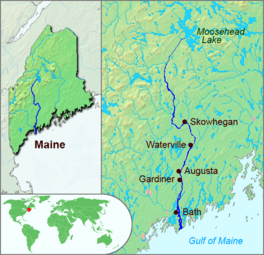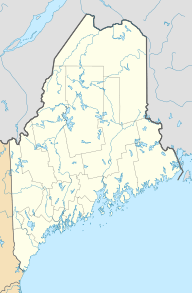Harris Station Dam facts for kids
Quick facts for kids Indian Pond |
|
|---|---|

Kennebec River, Maine. Harris Station Dam stands 12 miles (19 km) downstream from its source at Moosehead Lake, and Indian Pond floods the river for 9 miles (14 km) upstream of the dam.
|
|
| Location | Somerset County, Maine |
| Coordinates | 45°31′N 69°49′W / 45.517°N 69.817°W |
| Basin countries | United States |
| Max. length | 9 mi (14 km) |
| Surface area | 3,455 acres (1,398 ha) |
| Max. depth | 118 feet (36 m) |
| Water volume | 64,093 acre⋅ft (79,058,000 m3) |
| Surface elevation | 955 ft (291 m) |
The Harris Station Dam is a large hydroelectric dam located in Northeast Somerset, Maine, within Somerset County, Maine. It is also known as the Indian Pond Project. This dam was built between 1952 and 1954. It became the biggest hydroelectric dam in Maine at that time.
The dam holds back the water of the Kennebec River. It is found at the southern end of a natural lake called Indian Pond. This spot is about 12 miles (19 km) downstream from Moosehead Lake, which is where the Kennebec River begins.
Contents
What is the Harris Station Dam?
The Harris Station Dam is a special type of dam called a concrete gravity structure. This means it uses its own heavy weight to hold back the water. The dam stands 175 feet (53 meters) tall. It was named after Ford Harris, who was the main engineer for the company that built it, Central Maine Power.
How the Dam Makes Electricity
The main job of the Harris Station Dam is to create electricity. It does this by using the power of moving water. This process is called hydroelectric power. The dam can produce about 86 megawatts of electricity. This is enough power to supply many homes and businesses.
Today, the dam is owned and operated by a company called Brookfield Renewable. They manage the dam to keep producing clean energy.
Indian Pond Reservoir
The dam creates a large body of water upstream called a reservoir. This reservoir floods the Kennebec River valley. It stretches northeast through Indian Stream township into Sapling township. The reservoir is formed by the dam holding back the river's flow.
Rivers and Streams Flowing into the Reservoir
Many smaller rivers and streams flow into the Indian Pond reservoir. On the west side, you'll find Bog Brook, Gold Brook, Falls Brook, Coburn Brook, and Brandy Brook. On the east side, Burnham Brook flows in after draining Burnham Pond. Indian Stream also enters, bringing water from Little Indian Bog, Big Indian Pond, Trout Pond, and Moore Bog.
Fish in the Reservoir
The reservoir at Indian Pond is a great place for certain types of fish. It has very good cold water, which is perfect for them. You can find different kinds of fish here, including brook trout, lake trout, and land-locked Atlantic salmon. These fish are popular with anglers who enjoy fishing in the area.


